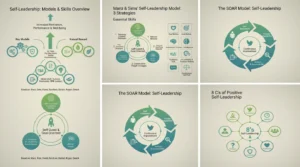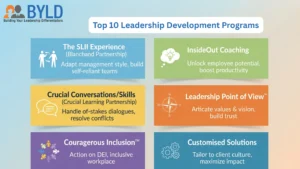
Team Effectiveness: Models, Strategies, and Best Practices for High-Performing Teams
- Our Subject Matter Experts
- June 30, 2025
- 5:50 pm
- No Comments

Table of Contents
Every organisation wishes to host exceptionally high-performing teams that reliably achieve results, roll up their sleeves, address barriers, and generate innovation. But effective teamwork isn’t just about putting skilled individuals together—it’s about fostering synergy, trust, and collaboration.
At this phase, the primary relevance of team effectiveness emerges. Organisations can implement team effectiveness models for reliable teamwork, creating cohesive units that deliver exceptional results.
This blog examines team effectiveness by studying basic principles, essential reasons for its value, and scientific research. It also presents methods for constructing effective teams that produce superior outcomes.
What is Team Effectiveness, and Why Does It Matter?
Team effectiveness represents an essential business concept whose value must be recognized.
A team reaches peak effectiveness through quick goal attainment and fostering team harmony among members during work processes. Excellent teams succeed at achieving their objectives through open communication and delivering training for all members separately and collectively. Team effectiveness produces goal completion and a harmonious workplace that supports promoting employees and ensures business longevity.
The three main elements that support team effectiveness include properly reaching targets, maintaining high-quality professional relationships, and holding team members to their responsibility standards. Outcomes from successful teams empower fellow members to maximize their potential while obtaining organizational success.
Why Team Effectiveness Is Important
Organizations achieve success through team synergy. Team effectiveness development brings extensive organizational advantages that extend throughout all departments.
- Organizations increase productivity by building effective teams that share tasks while maintaining quality communication and teamwork.
- Teams that collaborate successfully allow members to exchange different viewpoints to generate innovative solutions and creative thoughts.
- Motivated employees Work in successful teams because they show higher job satisfaction and morale. Workers in supportive cultures develop feelings of trust because of their shared sense of belonging.
- Better Problem-Solving: Organized teams integrate diverse perspectives and styles to solve problems effectively. The cooperative style produces more thoughtful and practical solutions.
In today’s hyper-competitive and globally connected work environment, team effectiveness is no longer optional but a requirement for long-term success. Organizations committed to building effective teams gain a substantial competitive edge by producing innovation, flexibility, and resilience.
By emphasizing team performance, companies achieve short-term success while building the foundation for long-term growth and sustaining success in the ever-evolving business climate.
The Science Behind Team Effectiveness
Creating a high-performance team is an art and science. Organizational behavior studies and psychology have identified the triggers that affect group performance and dynamics. These principles allow organizations to create teams that consistently produce outstanding results.
Key Factors Influencing Team Effectiveness
1. Psychological Safety
The psychological safety model created by Harvard professor Amy Edmondson centers on building a team culture where members feel safe to experiment, share ideas, and make mistakes without fear of punishment or criticism. Collaboration, creativity, and engagement are enhanced when members think they can be bold and honest without fear of retaliation.
2. Clear Goals and Roles
A successful team needs clear objectives, assigned member responsibilities, and the essentials for team success. Teams move forward with clear goals, which enable them to achieve assigned responsibilities and increase team efficiency while decreasing duplicated work efforts. A productive team operation emerges when members properly grasp their duties, creating team-wide productivity and a single performance output.
3. Diversity and Inclusion
Teams that include members of diverse backgrounds improve decision-making processes because their multiple viewpoints help generate new solutions. Team diversity becomes genuinely productive only when inclusion practices are implemented to guarantee that all team members believe they are valued participants in group activities. Leaders should develop settings that maximize interpersonal variations to reach higher performance results.
4. Effective Communication
Honest communication creates alignment between teams while helping members reach common goals. Team members who share information effectively prevent confusion while developing teamwork that helps resolve difficulties and share critical suggestions at higher efficiency levels.
5. Strong Leadership
A good leader is the key to building trust, directing the team to goals, and resolving conflicts positively. Great leaders motivate their teams, acknowledge personal contributions, and foster a culture of accountability and development. Their capacity to stay focused while supporting the team’s requirements guarantees long-term success.
Read More – How Work Personality Assessments Can Drive Team Productivity
BYLD's Perspective on Team Effectiveness
BYLD Group considers that discovering the science of team effectiveness is the beginning of a team’s true potential. By integrating training, tests, and functional tools, BYLD Group assists companies in adopting strategies that encourage cooperation, enhance communication, and cultivate leadership skills.
With scientific understanding and a customised approach, BYLD Group empowers companies with the knowledge and competencies to construct effective teams with the capacity to excel in the current complex and competitive business environment.
Ready to Build a High-Performing Team?
Exploring the Team Effectiveness Model
Many organisations examine systematized frameworks to enhance group effectiveness. One widely recognized approach is the Team Effectiveness Model.
What is the Team Effectiveness Model?
The team effectiveness model is a model that describes the essential elements of a functioning group. These components vary across models but generally include:
- Team Composition: Ensuring the right mix of skills, personalities, and experiences.
- Processes and Tools: Having transparent workflows and the tools necessary for collaboration.
- Goals and Metrics: Setting measurable objectives to track progress and success.
- Trust and Relationships: Establishing team trust to promote open communication and teamwork.
Example: The GRPI Model
Among the most common team effectiveness models is the GRPI model, which has the following core aspects:
- Goals: Clearly defined objectives.
- Roles: Clear responsibilities for each member.
- Processes: Well-established workflows and decision-making protocols.
- Interpersonal Relationships: Trust and respect among team members.
By using such models, teams can identify and address gaps, ensuring more cohesive and productive teamwork.
Building Blocks of Effective Teamwork
Some of these building blocks are necessary to get and keep high-performance teams. These form the foundation of effective teamwork:
1. Trust
Trust represents the critical base upon which all successful teams should build their operations. Trust between team members enables open collaboration, idea-sharing, and mutual support.
2. Communication
Team success becomes impossible with internal confusion and unclear goals because transparent team relationships help teams meet their common objectives.
3. Shared Vision
When team members share a goal, they maintain teamwork synergy and develop a strong sense of direction. This system ensures that every team member focuses on delivering identical goals.
4. Accountability
Results-based accountability exists within effective teams because members enforce responsibility to the team and themselves.
5. Adaptability
The modern workplace demands that teams transform and adjust their operations smoothly when circumstances shift while maintaining clear direction and unity.
BYLD Group stresses these elements in its training so that organisations can develop high-performing teams that excel at work and collaboration.
Measuring and Improving Team Effectiveness
Once a team is in place, how do you measure its effectiveness? The following are some methods of measuring team effectiveness and how to enhance it.
Measuring Team Effectiveness
- Performance Metrics: Assess whether the team is on or above target regarding its goals.
- Feedback Surveys: Collect feedback from team members regarding communication, collaboration, and morale.
- Observation: Leaders’ insights into team dynamics can help them describe their strengths and weaknesses.
Improving Team Effectiveness
- Set Clear Expectations: Ensure that every team member understands their role and the team’s goals.
- Encourage Open Communication: A productive environment should allow team members to provide feedback freely.
- Provide Training and Development: The organization should fund training and development sessions to help personnel increase their abilities at individual and group levels.
- Celebrate Successes: Team success should be celebrated through recognition because it enhances morale by demonstrating positive workplace behaviors.
At BYLD Group, we specialise in helping organisations implement practical strategies to measure and enhance their teams’ effectiveness.
Successful Team Effectiveness Model Implementation
Successful team effectiveness model implementation requires strategic planning and effective implementation. To build high-performing teams, organisations must approach their needs and goals in a structured manner. These steps are developed and executed to make the implementation successful.
Step 1: Identify Team Needs
Multiple aspects of team dynamics and obstacles maintain individual teams’ functioning as distinct entities. You need to determine the precise requirements of your team at this initial stage. Assess these gaps within your team structure, including unclear communication systems roles, roles, ambiguity, and insufficient collaboration efforts. The data collection methods for improvement opportunities consist of surveys, interviews, and assessments.
Step 2: Select the Right Model
The right team effectiveness model matters. Different models address different issues. The GRPI model (Goals, Roles, Processes, Interpersonal Relationships) is a team assessment tool that effectively evaluates team members with unclear roles and responsibilities. A team requires an operational model built for its existing structures while adapting to environmental requirements.
Step 3: Train Team Members
Successful deployment requires model selection training after selecting an appropriate model. Staff members need a perfect understanding of the framework, its components, and execution approaches. Practical, lively teaching methods coupled with workshop learning and coaching activities will guide team members toward better engagement and successful alignment.
Step 4: Track Progress
Time-based team performance assessments can be achieved through measurement tools that include feedback scores and achievement rates of team goals, together with interpersonal relationship dynamics. Both performance reviews and regular check-ins serve to evaluate whether the model achieves its designated targets.
Step 5: Adapt and refine
Universal applications of models do not exist in business practice. Ongoing evaluations connected to framework modification enable the framework to stay practical and relevant. Teams will provide feedback that drives changes to model components while new goals and environmental conditions require adjustments to the model.
BYLD Group provides comprehensive team effectiveness solutions that direct organisations through their transformational process. These steps allow firms to create collaboration, enhance performance, and achieve long-term success in an increasingly competitive world.
Read More – 5 Behaviors of a Cohesive Team: A Guide for Team Leaders
Conclusion
Team effectiveness is the key to organizational success. Organizations can structure a high-performing team that produces outstanding outcomes by understanding the factors contributing to effective teamwork, analyzing selected frameworks such as the team effectiveness model, and paying attention to the elements necessary for teamwork to succeed.
At BYLD Group, we’re committed to helping teams reach their full potential through training, coaching, and proven strategies. Whether building a new team or improving an existing one, the journey to team effectiveness begins with a commitment to continuous improvement.
Team effectiveness means reaching group objectives with strong collaboration, trust, and unity. Strong groups divide victory in delivering results, and they both support novel ideas and boost individual performance.
High team effectiveness proves key for organizations because it improves production rates alongside innovative thinking and positive staff satisfaction ratings. Through exceptional teamwork, organizations reach their targets effectively while solving their challenges, which builds a productive work environment and produces enduring organizational success.
A team effectiveness model includes descriptions that outline essential elements that enable teams to function efficiently. Through these models, organizations gain insight into determining teamwork excellence, which helps them deploy proper teamwork systems and develop better collaboration methods by assessing their goals, roles, procedures, and relationships.
Team effectiveness can be assessed using performance indicators (e.g., meeting goals and/or objectives), feedback surveys (on team dynamics), and observations (regarding communication and cooperation). Other factors can indicate group effectiveness, including employee happiness and turnover.
An effective team requires its members to establish trust and clear communication while sharing a common vision, being accountable to each other, adapting to changes, and having strong leadership. These elements work synergistically to support teamwork operations while generating group collaboration.
The GRPI model is a widely used team effectiveness framework that works on four key elements: Goals, Roles, Processes, and Interpersonal Relationships. The Team Development Model created by Tuckman has gained recognition for its description of team formation through four stages: forming, storming, norming, and performing.
To enhance team effectiveness, focus on the following strategies:
- Set clear goals and expectations.
- Foster open communication and trust.
- The organization should make training resources available for employees to develop professionally.
- Team members should collaborate because success should be recognized among all colleagues.
The regular evaluation of team dynamics will help teams overcome any emerging challenges.
Team effectiveness needs essential leadership as its foundation. A timely leadership method requires teams to establish paths and handle conflicts while developing trust relationships and providing continuous support to their members. Such leadership enables both free communication and team member accountability.
- Different viewpoints and various methods enable teams to resolve problems effectively.
- Unique viewpoints among team members drive creative thinking as well as innovative solutions.
- The decision-making process gets better due to the evaluation of multiple solutions.
- Higher adaptability and organizational resilience become possible when working in volatile environments.
- Solid leadership and an improved communication system work to prevent future conflicts.
- Handling well creates an environment of inclusion, teamwork, and group cohesiveness.
- A clear definition of roles and responsibilities provides a basis for the accountability of organizational members.
- Effective communication and collaboration facilitate the seamless dissemination of information.
- With a clear communication framework, conflicts are resolved faster and more efficiently.
- Teams get to realize their objectives faster with increased efficiency.
- A strong team culture stimulates innovation, growth, and engagement among members.
- Better productivity due to enhanced outputs with streamlined processes and teamwork.






